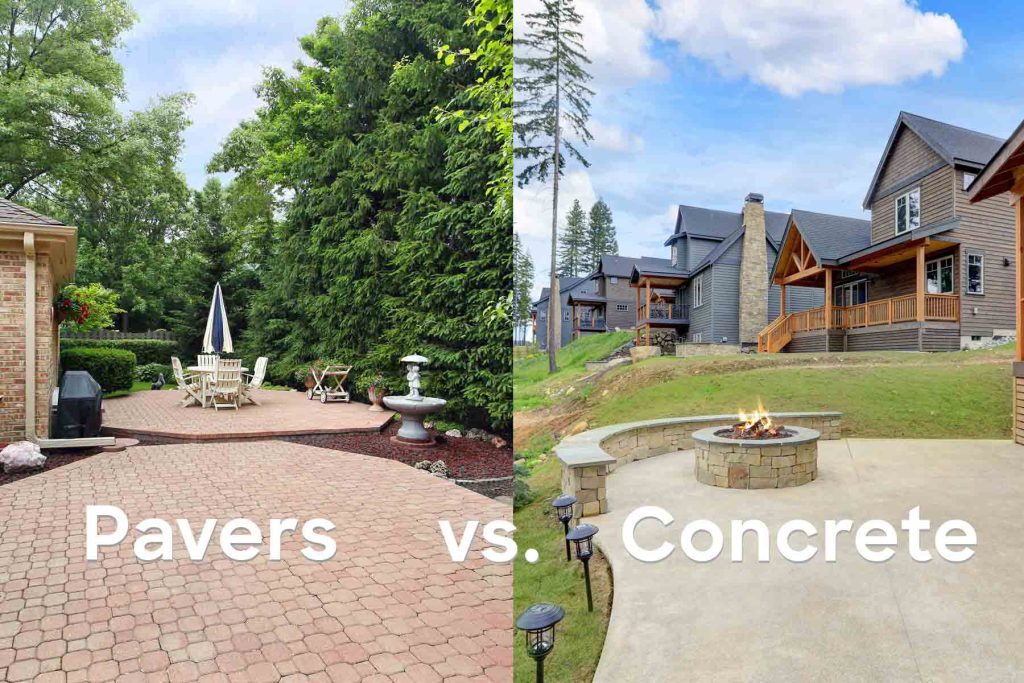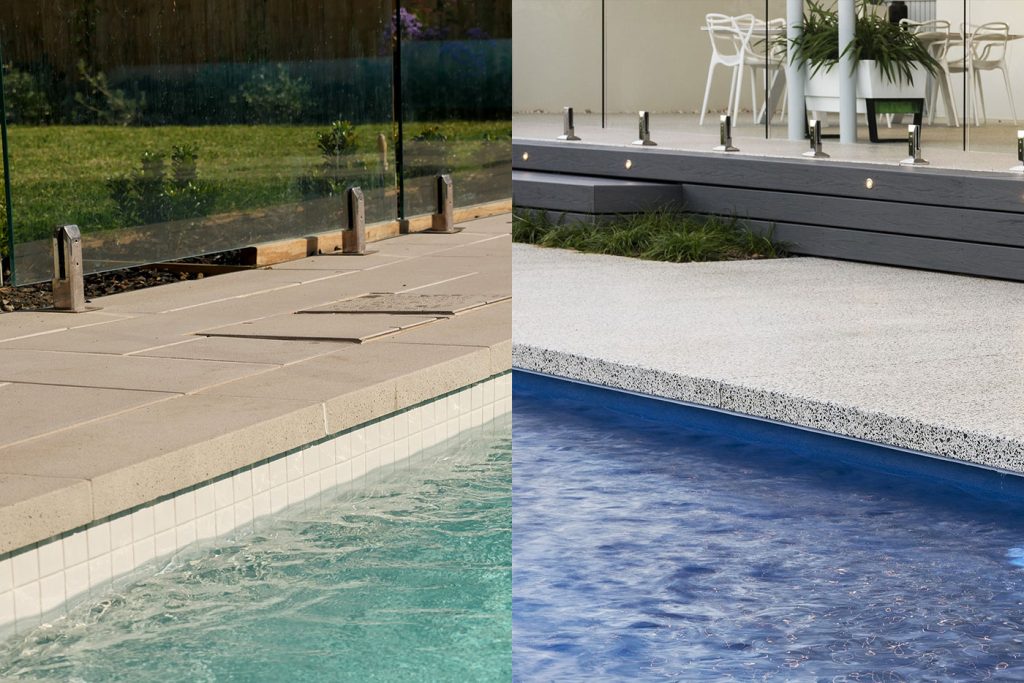Choosing between concrete pavers and concrete slabs for your outdoor space can make or break your landscaping project. With so many design options, durability factors, and budget considerations, it’s crucial to understand the strengths and weaknesses of each. Whether you’re building a patio, driveway, or poolside retreat, this comprehensive guide will help you answer the question: What is the difference between concrete pavers and concrete slabs? By the end of this post, you’ll be equipped with the knowledge to make a confident and informed decision.
What Is the Difference Between Concrete Pavers and Concrete Slabs?

Concrete pavers are individual bricks made from concrete, shaped and molded to fit together in patterns. They’re installed over a bed of sand and gravel, which allows for flexibility and drainage. Concrete slabs, also known as poured concrete, involve pouring a mix of concrete into a mold to create a large, continuous surface.
The main difference lies in installation and structure. Pavers are modular and flexible, while slabs are singular and rigid. This affects how each material handles wear, movement, and weather changes.
What Is the Difference Between Pavers and Slabs?
Many people use the terms “pavers” and “slabs” interchangeably, but they are quite different in form and function. Pavers are small, interlocking units made of concrete, stone, or brick, designed to move slightly without cracking. Slabs, on the other hand, are large, continuous sections of poured concrete that form a solid base.
This structural difference influences their performance. Pavers are ideal for driveways and patios due to their ability to withstand movement and heavy loads. Slabs may crack over time if the ground shifts or if expansion joints are not properly used.
What Is the Difference Between Concrete and Concrete Pavers?
Concrete is a versatile material made of cement, aggregate, and water. It can be poured into molds (slabs) or formed into smaller, pre-cast shapes (pavers). The key difference between poured concrete and concrete pavers lies in their manufacturing and installation.
Concrete slabs are poured and set on-site, while concrete pavers are manufactured in controlled environments, ensuring consistent quality and strength. Pavers tend to be more durable and less prone to cracking because their modular design allows for expansion and contraction.
Is Concrete Slab Cheaper Than Pavers?
Generally speaking, yes—concrete slabs are cheaper to install upfront than pavers. Slab installation involves fewer materials and less labor, making it an attractive option for budget-conscious homeowners. However, pavers can be more cost-effective in the long run.
Why? Because slabs are more likely to crack, especially in areas with soil movement or extreme temperature fluctuations. Repairing a slab can be expensive and invasive, while pavers can be individually replaced without disrupting the entire surface.
Concrete vs Pavers: Pros and Cons
Both concrete slabs and pavers have unique advantages and drawbacks. Here’s a detailed comparison:
Concrete Slabs Pros:
- Lower initial cost
- Faster installation
- Smooth, seamless look
Concrete Slabs Cons:
- Cracks over time
- Difficult and expensive to repair
- Can be slippery when wet
Concrete Pavers Pros:
- High durability
- Easier to repair (replace individual units)
- Customizable patterns and colors
Concrete Pavers Cons:
- Higher upfront cost
- Installation takes more time and labor
- Weeds can grow in joints if not sealed
What Is Cheaper: Poured Concrete or Pavers?
When calculating the overall cost, poured concrete is initially cheaper, but maintenance costs should not be overlooked. Poured concrete may require patching, sealing, or even replacement. Pavers, while more expensive initially, tend to have a lower lifetime cost due to easy maintenance and long-lasting durability.
Stamped Concrete vs Pavers Cost
Stamped concrete offers a decorative touch by mimicking the look of pavers, brick, or even natural stone. It’s more expensive than regular poured concrete but usually still cheaper than pavers. However, it doesn’t offer the same flexibility or longevity as true pavers.
Stamped concrete can crack like regular slabs, and repairs are often more noticeable and difficult. Pavers, by contrast, are easy to maintain and replace, giving them an edge in terms of long-term value.
What Is the Difference Between Concrete Pavers and Concrete Slabs QUI
The “QUI” here may refer to quick installation. If speed is a priority, concrete slabs are generally faster to install. One can pour and finish a concrete slab in a day or two, while paver installation takes longer due to the need for base preparation, leveling, and precise placement.
However, faster doesn’t always mean better. The extra time spent on paver installation pays off in terms of durability, aesthetics, and ease of future repairs.
Pavers vs Concrete Driveway
Concrete driveways are popular due to their affordability and ease of installation. However, they are more prone to cracking and can suffer under the stress of heavy vehicles. Pavers, on the other hand, are designed to withstand heavy loads and are less likely to crack or shift.
In terms of appearance, pavers offer more design options and can significantly boost curb appeal. If you plan to sell your home in the future, a paver driveway can add value.
Pavers vs Concrete Patio
For patios, pavers win in terms of customization and aesthetics. You can choose from a wide variety of colors, textures, and layouts to match your outdoor design. Concrete slabs offer a clean and simple look, but they lack the character that pavers bring.
Additionally, patios often experience settling and shifting. Pavers adapt better to movement, while slabs can crack and become uneven.
Where to Buy 24×24 Concrete Pavers
If you’re specifically looking for 24×24 concrete pavers, you can explore local landscaping supply stores, big box retailers like Bunnings or Mitre 10, or directly from suppliers featured on oceanlandscapes. Buying from a local provider ensures faster delivery, and you can often see samples in person before purchasing.
Pavers vs Concrete Around Pool

Safety is paramount around pools, and this is where pavers shine. They provide better traction and are cooler underfoot compared to slabs. Pavers also offer excellent drainage, which reduces the risk of slipping.
While poured concrete is cost-effective, it can become slippery when wet and may crack due to constant moisture exposure. Pavers are a safer and longer-lasting investment for pool areas.
Conclusion
The choice between concrete pavers and concrete slabs comes down to your budget, design goals, and long-term expectations. If you’re looking for a cost-effective, quick solution, slabs may work. But for durability, visual appeal, and easier maintenance, pavers offer unmatched advantages.
Before making your final decision, consider how the area will be used, the local climate, and your future maintenance preferences. For expert guidance and access to premium materials, visit oceanlandscapes .
FAQs: Concrete Pavers vs Concrete Slabs
What lasts longer—concrete pavers or slabs? Concrete pavers generally last longer than slabs because they handle ground movement better. Cracks are less likely since the design allows for slight shifting.
Are pavers better than concrete for driveways? Yes, especially in terms of durability and curb appeal. Pavers are stronger and less likely to crack, while offering a premium look.
Can I DIY install concrete pavers or slabs? Both are possible to DIY, but pavers require more skill and precision. Slabs are quicker to pour but need careful leveling and curing.
Do pavers need more maintenance than slabs? Pavers may need occasional re-sanding and sealing, but they are easier to repair. Slabs may require patching, sealing, or full replacement if cracked.
Which is more eco-friendly? Pavers allow better water infiltration, reducing runoff and helping with drainage. This makes them a more eco-friendly choice compared to solid concrete slabs.
What should I use for a pool area—pavers or concrete? Pavers are preferred around pools due to their slip-resistance and cooler surface temperature. They also drain water more effectively.
Where can I get expert help with landscaping and paving? For premium landscaping services and a wide range of pavers, reach out to the specialists at oceanlandscapes. Their team can guide you through every step, from material selection to final installation.
